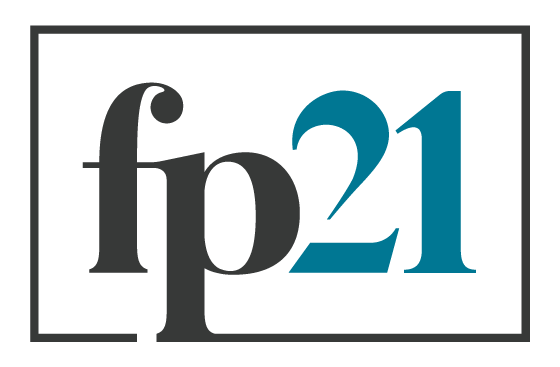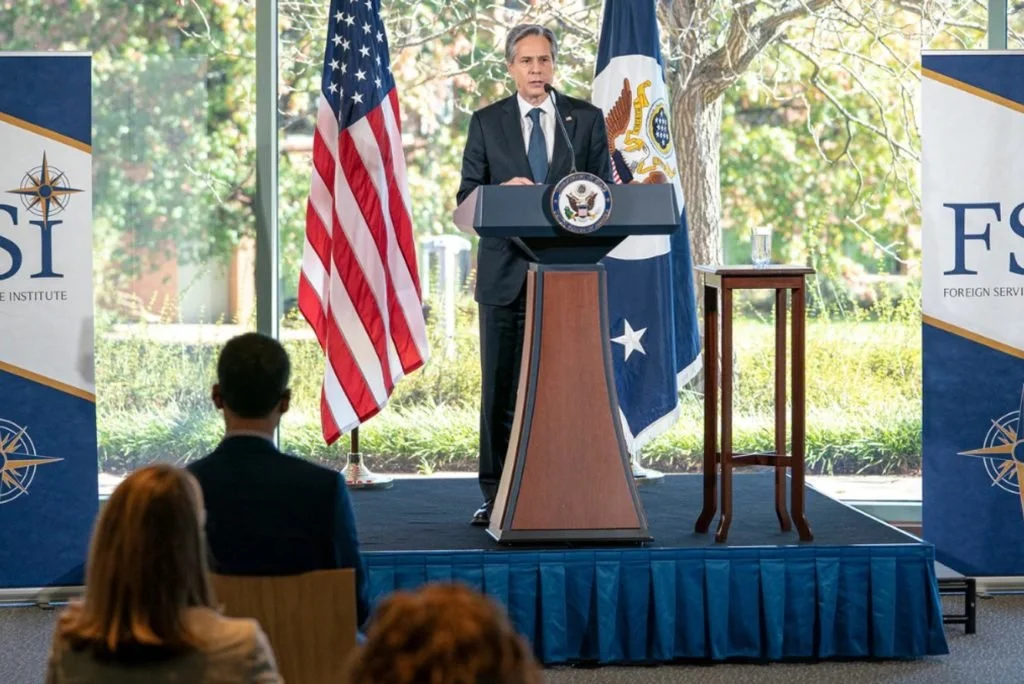Doctrine for Diplomacy: To Remain Relevant, the U.S. State Department Needs a New Statecraft
By: Dan Spokojny | August 10, 2022
Picture a seasoned American diplomat preparing to lead a ceasefire negotiation to end a violent civil war. You might imagine her carrying a dog-eared manual that describes a variety of negotiation techniques, guidelines for assembling a well-rounded team, and a summary of best practices for achieving success. As her jet lands in a war-torn country, she is thumbing through comparative case studies of the most durable peace agreements to prepare to score a big win for U.S. diplomacy and international peace.
Unfortunately, no such manual exists. The State Department has not developed any standard operating procedure for successfully managing peace processes. Indeed, it has no clear methods and procedures for the conduct of diplomacy. Whether the United States is supporting a democratic election, combatting terrorism, or advancing human rights, diplomats are expected to figure things out for themselves.
Many wizened diplomats wax poetic about the “art of diplomacy,” suggesting that policy effectiveness arises from an elusive combination of good judgment and hard-earned experience. But art requires technique and fundamentals. Good foreign policy must be more than simply a matter of taste. The military has doctrine. The intelligence community has tradecraft. But U.S. diplomacy has not kept pace. It is time to start treating the conduct of diplomacy as a profession with its own standards, methodologies, and skills. Let’s call it statecraft.
What Is Doctrine?
“Doctrine consists of the fundamental principles that guide the employment of U.S. military forces in coordinated action toward a common objective,” explains the Joint Doctrine for the Armed Forces of the United States. “It provides the authoritative guidance from which joint operations are planned and executed.” The Army writes that doctrine also includes the “supporting tactics, techniques, procedures, and terms and symbols used … as a guide for actions.” The Air Force adds that “doctrine is the extant and emerging best practices in the application of airpower.”
If that seems clear as mud, it is. The influential naval strategist Wayne Hughes Jr. explained that “doctrine is self-defining … it is whatever the issuing authority wants it to be: principles or practice; guidance or prescription; precise or flexible; structural or procedural.” Doctrine can encompass strategy, principles, beliefs, processes, rules, training, norms, expectations, habits, and more.
Perhaps the best definition of doctrine comes from the Army, which describes doctrine as “the approved body of knowledge that is taught.”
Doctrine’s power derives not from a one-size-fits-all definition, but from its ability to help an organization achieve results. This raises the question: What role should doctrine for diplomacy play at the State Department?
“An Approved Body of Knowledge That Is Taught”
Doctrine’s first task is to describe how to achieve foreign policy success. Statecraft must spell out the cause-and-effect relationship between levers of influence and the world it hopes to shape.
As the scholar Dan Reiter noted, “Like good carpenters, foreign-policymakers need to know their tools.” Whether drafting peace agreements, building a sanctions program, countering human rights violations, or supporting a democratic election, policymakers should have access to a set of evidence-based best practices. No two foreign policy situations are the same, but oft-repeated foreign policy challenges and opportunities are common enough to make the identification of best practices feasible.
To this end, the State Department should ask its diplomats to feed their experiences into U.S. diplomacy’s larger body of work to constantly improve and update American statecraft. The most experienced and innovative experts in diplomacy should be encouraged to study and innovate U.S. diplomatic doctrine — just as Gens. David Petraeus and James Matthis led a diverse group of experts to draft a counterinsurgency field manual that changed the course of the war in Iraq.
The State Department might draw instruction on how to create doctrine from those who have successfully bridged the divide between policymaking and research. After finishing his tenure as deputy to the ambassador to the United Nations in 2015, for example, Jeremy Weinstein returned to academia and embarked on a research study to evaluate best practices in freeing political prisoners. Through in-depth interviews with U.S. officials and analysis of media coverage, the study rejected a widely held belief that public pressure was responsible for securing the release of prisoners. The study found that “public pressure resolved deadlocks within the foreign policy bureaucracy, enabling private diplomacy and specific inducements to secure the release of political prisoners.” In sum, Weinstein created a validated recipe for the release of future political prisoners.
Endless think–tank reports and articles have recommended improving training at the State Department. As Kori Schake writes in State of Disrepair, Congress has in recent years authorized several significant increases in staffing to support better State Department training, but “there has been no major effort to develop a core curriculum of knowledge that diplomats need.”
New requests to increase training at State will not be taken seriously by a skeptical Congress unless a stronger link is made between training and impact. Doctrine must be validated, approved, and trained to make a difference in the conduct of diplomacy.
Making doctrine official invites study, evaluation, debate, testing, and continual improvement. It enables learning and provides a sturdier platform for Congress and the American people to hold U.S. foreign policy accountable for achieving its stated goals. Doctrine communicates what the State Department expects of its recruits, what must be trained, and what is necessary for promotion and leadership.
It is vital to recognize that doctrine contains much more than book knowledge. Doctrine provides what the scholar Geoffrey Sloan calls a “bridge between thought and action.” It operationalizes wisdom by creating processes and habits to ensure best practices are applied. The State Department should be more than just an assortment of intelligent employees and siloed offices. Statecraft can maximize the organization’s ability to organize its people, information, and resources, and bring unified action to achieve its goals.
Ultimately, doctrine will help the State Department advance its mission by clearly communicating its unique value to the president, interagency, Congress, and the American people. U.S. diplomats should convince their political leadership and interagency partners that they are responsive to — and capable of achieving — big foreign policy goals.
Overreliance on “Good Judgment” Is Dangerous
The absence of doctrine for diplomacy has real consequences for U.S. foreign policy. Diplomacy’s ambiguity contributes to its marginalized role in the interagency process and an overreliance on military and covert instruments of power. Its lack of clear standards greases the skids for unqualified political appointees to populate the State Department’s ranks at unprecedented rates. And subjective evaluations of expertise provide fertile ground for prejudices that block talented women and minoritiesfrom positions of authority.
Today’s diplomats are asked to rely on “good judgment.” But if good judgment is entirely subjective, expertise becomes arbitrary. Diplomatic doctrine can elevate a more widely accepted definition of foreign policy expertise. When diplomats lack a shared understanding of how policies work, decisions are too easily affected by personality and politics. Indeed, the clearance process at State is not designed to debate evidence but rather to seek consensus. In such a setting, information that complies with one’s preexisting view of the situation is privileged, while the best available evidence is easily overlooked. For example, when a secretary of state claims that poverty causes terrorism despite a great deal of research suggesting otherwise, it risks wasting precious resources and undermining national security. Without clear standards of policy excellence, self-interest thrives, fueling turf battles and partisanship.
Organizations that lack a shared understanding of how to achieve success are bound to underperform. In such a setting, “Managers have a strong incentive to worry more about constraints than tasks, which means to worry more about processes than outcomes,” explains Hugh Heclo, the influential scholar of organizational management. This describes the State Department well, where officials often stay busy writing cables and delivering talking points for policies everyone knows will fail.
I experienced this firsthand as a foreign service officer. I was not taught how to conduct a successful negotiation, develop effective strategy, counter misinformation, design a conflict prevention program, or any of a thousand other tasks I was assigned. The result is that I and every other diplomat think about our work differently, and no process exists to identify and propagate which tactics work best. An army would never send its troops into combat without first training them on operations, tactics, and maneuvers. Unfortunately, that is exactly what is expected of diplomats, to whom doctrine is not provided.
Diplomats do, of course, receive significant training. The Foreign Service Institute offers hundreds of courses across a wide range of subjects. I spent the first nine months of my career as a diplomat at the institute immersed in training. But my classes were largely focused on procedures, language training, and soft skills, rather than instruction on how to achieve policy objectives. “Lacking a true training complement,” explains a 2019 report from the American Academy of Diplomacy, “State concentrates most formal [Foreign Service Institute] training for [foreign service officers] on language acquisition.” I, like most officers, received virtually no additional training on the substance of foreign policy during the rest of my career. In the absence of diplomatic doctrine — the “approved body of knowledge” — more training does not equate to better diplomacy.
The “desperation and disorganization that consumed frontline State Department employees” during the military’s departure from Afghanistan exemplifies the pitfalls of failing to create official strategies and processes. The successful evacuation of Americans from Lebanon in 2006 should have provided a template to develop and train on clear doctrine. Yet the wheel was reinvented during the withdrawal from Afghanistan, during which “officials say they were unclear of their own authorities and what policies they were allowed to employ to help evacuate people.”
Reflecting on potential mistakes in Afghanistan, Secretary of State Antony Blinken stated, “We owe it to ourselves … to capture all that we learned, to study it, to apply it, to preserve it in a way that it enhances our future planning and helps us prepare better for future contingencies.” But such words are empty without systems to convert lessons into future action. We are left to constantly reinvent the secret sauce of past policy successes and overlook history’s lessons.
By learning the hard-earned insights of U.S. diplomats and incorporating them into diplomatic doctrine, the State Department can pass on wisdom to future generations. We can root out the practices that consistently produce failures and double down on policies that demonstrate success.
Overcoming a Cultural Resistance to Reform
Many diplomats are skeptical of the idea of codifying knowledge and evaluating success. They point out that diplomacy is necessarily fuzzy and resistant to generalized learning. Critics will worry that statecraft will rob leaders of their flexibility and creativity. In World War I, for instance, outdated military doctrine led Britain to suffer nearly 60,000 casualties on a single day, advancing its troops en masse at German machine guns at the Battle of the Somme.
Rather than marginalizing diplomats and turning them into automatons, doctrine can expand the boundaries of their understanding of the international system and empower more decisive action. The U.S. Marines, and most other fighting forces, include a vital coda in their doctrinal manuals to guard against such subordination: “Doctrine is authoritative but requires judgment in application.”
Another challenge to overcome is risk aversion, which has become the norm at the State Department dating back at least to McCarthy-era purges of China experts falsely accused of being communist sympathizers. Generations of diplomats have received the same advice: Don’t rock the boat, always make your boss look good, and avoid making strong claims that can be construed as failure if they don’t work out. Such risk aversion creates negative feedback loops that must be overcome if the State Department is to grow out of its reputation as a “bowl of jello,” in the words of President John F. Kennedy.
Effective statecraft should be centered on the relentless pursuit of policy success. Staying one step ahead of the competition requires the State Department to become a learning organization. Best of all, the design and adoption of doctrine will not require the State Department to ask anything new from the president or Congress.
As this country’s first executive agency, the State Department has helped build a more peaceful and secure world order. It houses extraordinary public servants whose hard-earned expertise derives from years of experience, study, and training. Such leaders know a great deal about the world. Yet, as the world grows more competitive and complex, the State Department can only continue this vital work if it evolves. Creating a doctrine for diplomacy will improve the quality, accountability, and effectiveness of America’s foreign policy.


